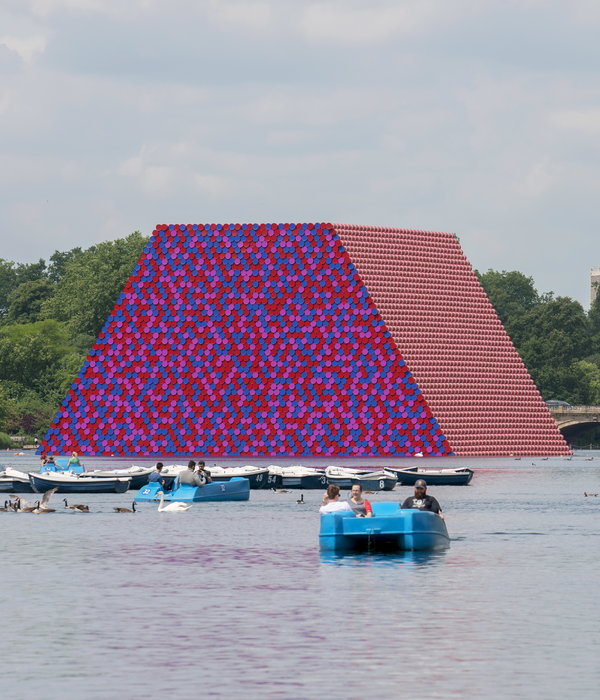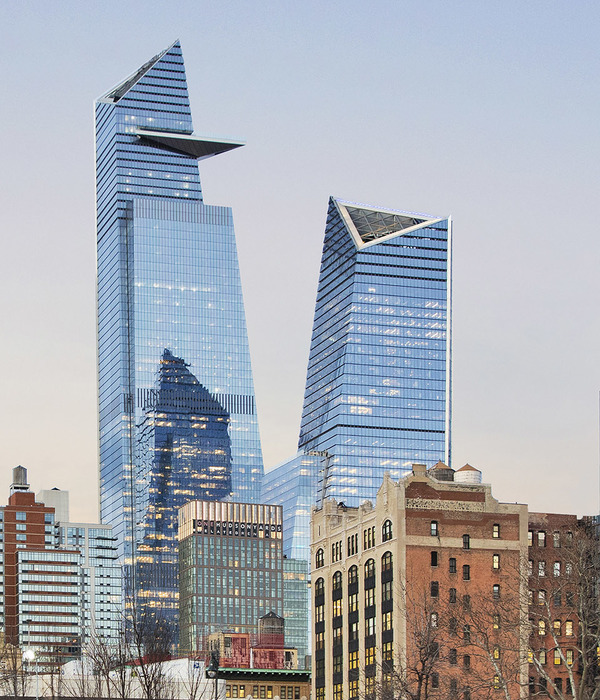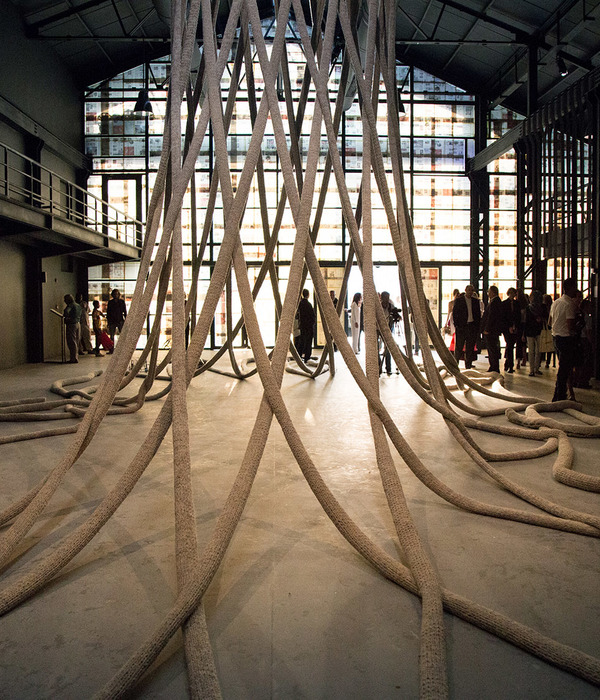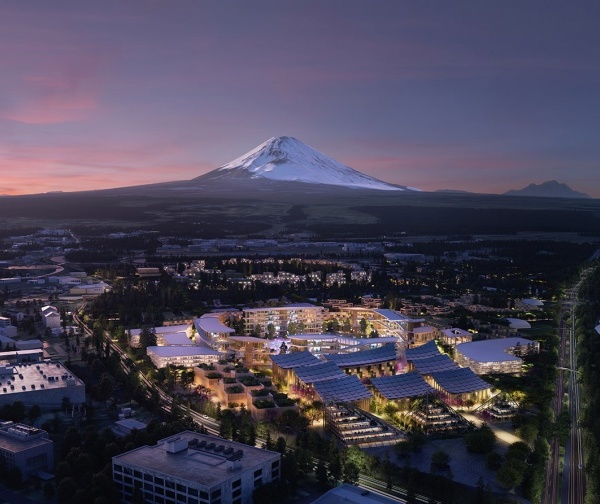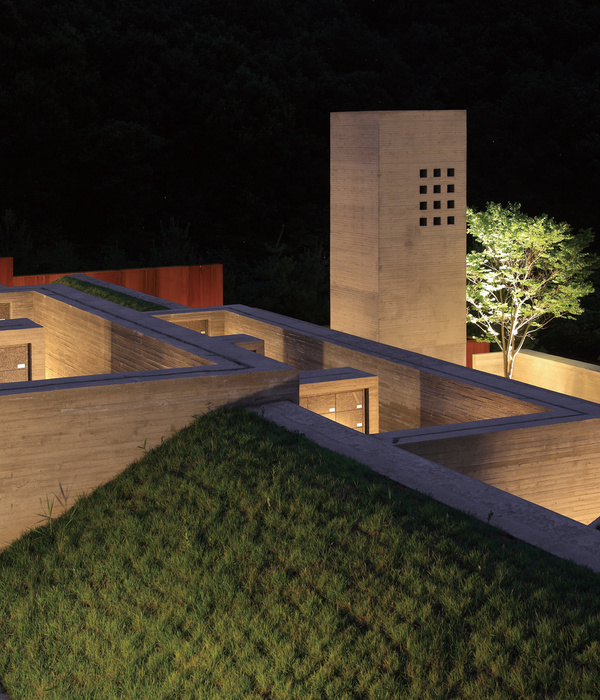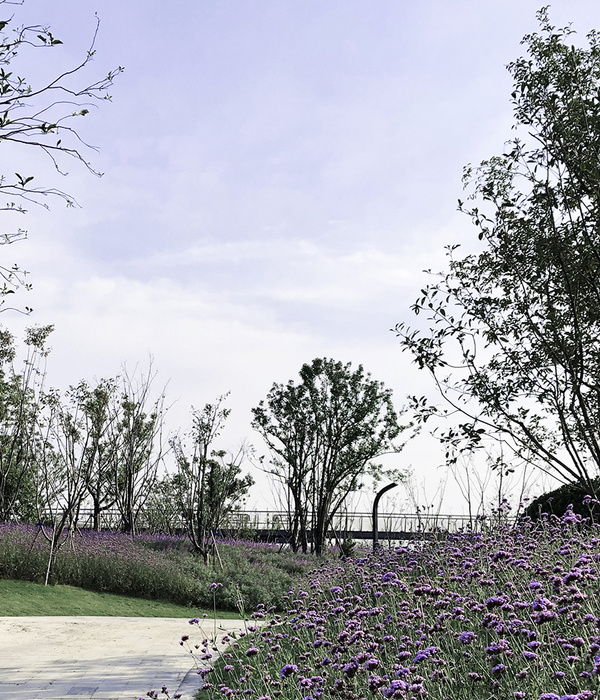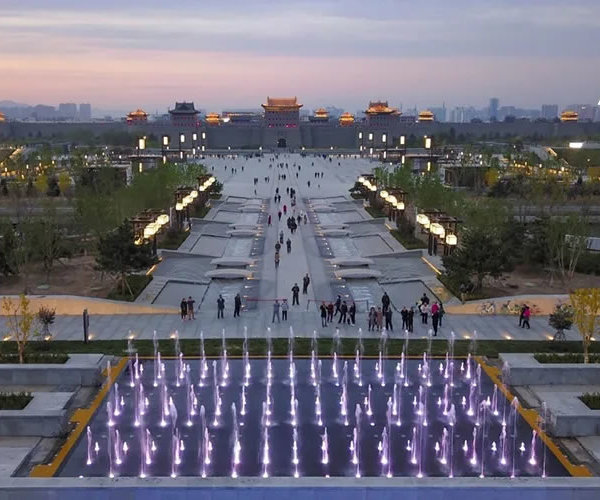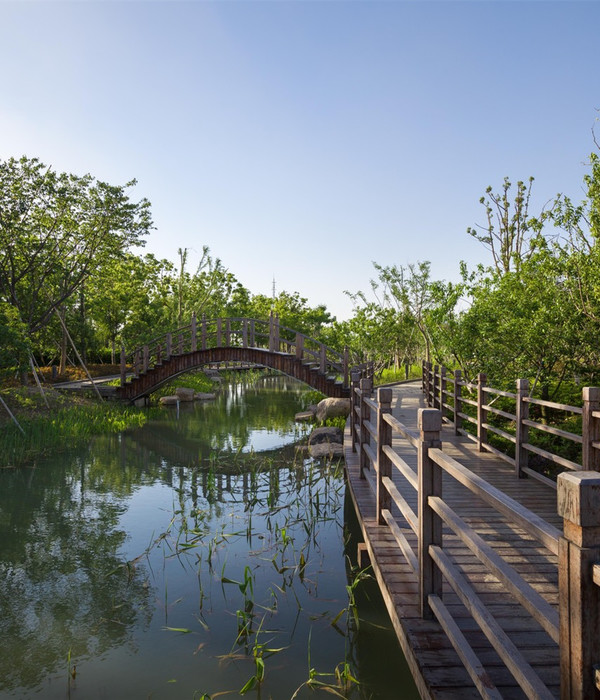背景简介
Introduction to the General Background
大运河蚕桑学校旧址文化公园(西陵堂公园)位于苏州“运河十景”之一的浒墅关河畔,总面积约3.27公顷,是在具有百年校史的原苏州蚕桑专科学校校址之上改造而成的城市文化公园。该项目的落成,在满足市民高品质环境需求的同时,也将唤醒蚕桑学校时光记忆,成为大运河国家文化公园沿线中场地文化复兴的典范。本公园共分两期,目前一期已施工完成并投入使用。
The Cultural Park of the Former Suzhou Sericulture College Site (Xiling Hall Park) is located along the riverbank of Xushuguan, one of the “Ten Scenic Spots of the Grand Canal” in Suzhou. Covering a total area of approximately 3.27 hectares, it has been transformed into an urban cultural park on the site of the original Suzhou Sericulture College, which has a century-old history. The completion of this project meets the high-quality environmental needs of the citizens while simultaneously reviving the time-honored memories of the Sericulture College. It becomes a model for cultural revitalization along the Suzhou section of the Grand Canal National Cultural Park. The project is divided into two phases, with Phase One already completed and opened to the public.
▼项目鸟瞰,Aerial view of the project ©中国建筑西北设计研究院,张锦影像工作室
缝史于今:大运河畔的肌理重塑
Combination with history and present: Reshaping the texture along the Grand Canal
作为大运河文化的重要组成部分,蚕桑学校的历史,最早可以追溯到1903年史量才创办的上海私立女子蚕业学堂。此后几经更名辗转,于抗日战争胜利后,学校迁回浒墅关原址复校,并于1995年并入苏州大学,留下该处旧址。
在城市发展的演进中,蚕桑学校作为中国近代教育史的见证者逐渐被遗忘,凝滞于城市发展历程之中,随着大运河苏州段的逐步启动,蚕桑公园作为苏州运河历史文化及中国蚕桑教育发展的重要载体,迎来重生的契机。城市格局的不断更迭使得蚕桑学校的自身角色发生了转变:从教育场所到开放公共空间。
▼旧址现状环境,Today’s environment of the former site © 中国建筑西北设计研究院
As an important part of the Grand Canal culture, the history of the Sericulture College can be traced back to 1903 when it was founded as a private female sericulture school in Shanghai by Shi Liangcai. After undergoing several name changes and relocation, the school returned to its original site in Xushuguan after the victory of War of Resistance Against Japan and merged into Suzhou University in 1995, leaving behind this former site.
Amidst the evolution of urban development, the Sericulture College, as a witness to modern Chinese education history, gradually faded into oblivion, stagnating with the city’s development . Now, with the gradual activation of the Suzhou section of the Grand Canal, the Sericulture Park, as an important carrier of Suzhou’s canal history and the development of Chinese sericulture education, has come to rebirth. The continuous transformation of the urban landscape has led to a change in the role of the Sericulture College itself: from an educational institution to an open public space.
▼“两河”汇聚的城市舞台,The urban stage where the two rivers converge © 张锦影像工作室
如何在延续场所记忆与城市文化基因的同时适应新的城市公共生活职能,将旧的历史遗迹融入到新的城市肌理之中,使其在新时代背景下持续焕发活力,成为本次设计的重要课题。
通过翻阅校史资料,决定以1957年测绘图为基础,梳理具有校园文化特色与时代记忆的场所点位,复原校园布局肌理,以形成本次景观设计的基础构架。
▼现状城市肌理与1957年蚕桑学校校址肌理,The current urban texture and the texture of the Suzhou Sericulture School site in 1957© 中国建筑西北设计研究院
▼基于场地现状的校园肌理再现,Recreating the campus texture based on the site’s current state©中国建筑西北设计研究院
It is one of the most important topics of the design project that how to preserve historical memory and urban cultural heritage while adapting to new public functions within the city, and integrate old historical relics into the new urban fabric with their vitality in the contemporary context.
By delving into the school’s historical records, the 1957 survey map has been chosen as the basis for identifying key locations that embody the unique cultural characteristics and memories of the campus, and for recreating the campus layout, forming the foundational framework for the landscape design.
改造后总平面,Site plan after reconstruction ©中国建筑西北设计研究院,张锦影像工作室
记忆回归:功能延续下的迭代与重生
The rejuvenation of memories: Iteration and rebirth of the functional extension
尘封的记忆应被唤醒,留存的场所亟待激活,设计基于校园的历时性和公园的当代性,将旧时校园记忆场景与现代公园功能需求进行对位重叠,利用低干预的针灸式改造将场地功能进行延续。
校园大门承载着几代学子对蚕校的深刻记忆,设计按照历史照片将旧时校门进行1:1的比例复原,并以此塑造入口界面,实现对旧时校园生活的场景转化。
▼校园大门、排球场、教学建筑、林荫道、莘园仍旧保留原有景观功能融入场地,The campus gate, volleyball court, academic buildings, tree-lined path, and Shen garden retain their original landscape functions, seamlessly blending into the area© 中国建筑西北设计研究院
The dusty memory are to be awakened, and the retained sites are ready to be reloaded. Based on the diachronicity of the campus and the contemporaneity of the park, the design seeks to merge the memorial scenarios of the old campus with the contemporary functional needs of a park, using minimally intrusive pinpoint renovation to maintain the site’s functionality.
The campus gate embodies deep memories for generations of students at the Suzhou Sericulture College. Following the old photographs, the original styled campus gate has been faithfully restored in a 1:1 ratio, shaping the entrance interface to recreate the scenes of campus life from bygone days.
▼校门历史照片,Historical photos of the gates© 中国建筑西北设计研究院
▼复建后的东大门再现旧时大运河畔的校园记忆,Reconstructed east gate reminiscent of the campus memories by the Grand Canal © 张锦影像工作室
▼夜色下的公园东门,East gate of the park at night© 张锦影像工作室
▼更新后的公园西侧主界面,Newly renovated main entrance on the west side of the park© 张锦影像工作室
排球场作为旧时校园的主要活动广场,本次改造保留其场所痕迹,强化集会功能,通过校园道路复原使其成为东西干道的交汇空间,成为公园的中心广场。
As the main gathering space of the former campus, the volleyball court retains its historical trace in this renovation, emphasizing its assembly function. Through the restoration of campus pathways, it becomes the central square of the park, intersecting the east-west thoroughfare.
▼排球场成为场地的中心枢纽,Volleyball court as site’s central joint© 张锦影像工作室
▼由西大门进入中心广场,Through the west gate to the central square© 张锦影像工作室
1918年,郑辟疆出任江苏省女子蚕业学校校长,将蚕校职业教育的功能推向了高峰。本次设计对其纪念雕塑进行复原,并迁至中心广场古香樟树下,面朝西大门,作为广场空间序列的基准点。
In 1918, Zheng Pijiang assumed the role of principal at the Jiangsu Women’s Sericulture School (i.e., Suzhou Sericulture College), elevating the vocational education function of the sericulture college to its zenith. The design project aims to meticulously restore and relocate the commemorative sculpture of Zheng Pijiang beneath the ancient fragrant camphor tree at the central square, oriented towards the west gate, serving as the focal point for the square’s spatial sequence.
Former principal’s sculpture beneath the ancient fragrant camphor tree© 张锦影像工作室
广场北侧的催青楼又名绿叶楼,在1912年—1937年作为蚕室楼使用,是唯一保留的战前教学建筑。本次设计依据原楼照片,结合民国建筑风格进行修缮和亮化提升,作为公园室内展陈场所。
The Cuiqing Building, also known as the Luye Building and situated to the north of the square, served as a silkworm rearing facility from 1912 to 1937, representing the sole surviving pre-war educational building. Guided by the original building’s photograph and in harmony with the architectural style of the Republic of China, the design project renovates and enhances it to function as an indoor exhibition space within the park.
▼修缮后的催青楼,Revamped Cuiqing Building©中国建筑西北设计研究院,张锦影像工作室
1947年前后校友为蚕校出资捐建小礼堂,因纪念传说中发明了养蚕、抽丝、做衣裳而尊为〈女神〉的西陵氏而取名西陵堂。本次设计依据原址风貌进行了修整,作为公共报告厅继续使用。
Around 1947, school alumni contributed funds to erect a small auditorium for the sericulture school, naming it Xiling Hall in homage to the legendary figure Xiling Shi, credited with the invention of sericulture, silk reeling, and clothing making. The design project revitalizes the original site to maintain its role as a public lecture hall.
▼修缮后的西陵堂,Revamped Xiling Hall©中国建筑西北设计研究院,张锦影像工作室
旧时的校园林荫道作为贯通公园南北的道路骨架被延续。
The tree-lined path of the old campus, serving as the backbone road connecting the park’s north and south, is to be extended.
▼校园林荫道成为公园主干路,The campus tree-lined walkways now serve as the park’s main pathway© 张锦影像工作室
莘园是七六届校友捐建的一座具有苏式园林风格的小游园,本次设计对小游园进行了全面修葺,并对园内的一山、一池、一台、一亭、一廊、一径进行了重点提升,以重塑步移景异之妙,延续蚕校简朴淡雅、清爽幽静的园林氛围。
Shen Garden, a small Suzhou-style garden funded by the Year of 1976 graduates, has undergone a comprehensive facelift. The design focuses on enhancing the garden’s mountain, pond, terrace, pavilion, corridor, and path to recapture the beauty of ever-changing scenery, perpetuating the simple and elegant, refreshing and tranquil garden ambiance of the sericulture school.
▼莘园鸟瞰平面,Aerial view of the Shen garden © 张锦影像工作室
▼民国建筑与苏式园林的场所对话,Interplay between Republican architecture and Suzhou-style gardens©中国建筑西北设计研究院,张锦影像工作室
▼从月洞门望向园内,Looking into the garden through the moon gate©中国建筑西北设计研究院,张锦影像工作室
▼黄石主峰与古桑树“共生”,The yellow stone peak “coexists” with the ancient mulberry trees©中国建筑西北设计研究院,张锦影像工作室
▼园林长廊的阅读、休憩功能延续,The garden corridor continues offering space for reading and resting©中国建筑西北设计研究院,张锦影像工作室
▼莘园外围墙修缮做旧,Outer wall of the Shen garden is repaired and intentionally made to look weathered©中国建筑西北设计研究院,张锦影像工作室
▼时光镌刻,Etching of time © 佟阳,张锦影像工作室
现代转译:文化赋能下的场所重塑
Modern transformation: Site refinement under the empowerment of culture
春蚕不死,化蝶新生。场地属性的转变,使部分旧址空间失去原有功能,设计通过对场地元素的现代转译,在运河文化与校园文化的双重赋能下进行场所重塑,以满足公园的使用需求,接续场地记忆,创造新活力。
Much like the silkworm’s cacoon-break , the shift of the site’s attributes has rendered some of its former spaces devoid of their original functions. Through the modern reinterpretation of site elements and the dual empowerment of canal culture and campus culture, the design reshapes the site to meet the park’s usage needs, perpetuating the site’s memories and fostering new vitality.
▼对气象台、游泳池、体育馆及北入口进行场所重塑,Reshaped meteorological station, swimming pool, gymnasium, and northern entrance © 中国建筑西北设计研究院
通过对旧址的民国风格建筑、校园蚕桑工艺中的形态元素进行提取转化为场地新的设计语言。
By extracting and transforming the formative elements of Republic of China-style buildings and the sericulture craft from the campus, the new design language of the project has formed.
▼场地元素提取,Site elements extraction©中国建筑西北设计研究院
旧址中的气象台、游泳池、体育馆已经损毁或不再满足公园使用需求,而场地北端作为新增入口也需被重新定义。设计针对这些区域进行了差异化的改造提升,与延续的旧址功能节点接驳,重构新旧并存、时空对话的蚕校文化体验。
The former site of Suzhou Sericulture College has seen significant deterioration in its meteorological observatory, swimming pool, and gymnasium, rendering them unsuitable for park usage. Additionally, the northern entrance area needs to be re-defined. To address these areas, a distinctive transformation plan has been devised to revitalize the park while maintaining continuity with the existing functional nodes, thus creating extensive interaction between the old and the new, and fostering a cultural experience that transcends time and space.
▼区域鸟瞰图,Aerial view of the region © 张锦影像工作室
现状体育馆坍塌严重,设计结合旧照,在原址上对建筑进行复建,将作为公园活动馆使用,原馆前篮球场保留场所记忆作为活动广场继续使用。
Referencing historical photographs, the severely dilapidated gymnasium is reconstructed in its original location and repurposed as a venue for park activities. The former basketball court in front of the gymnasium is preserved to retain its historical significance and serves as an event plaza.
▼复建后的体育馆,Reconstructed gymnasium ©中国建筑西北设计研究院,张锦影像工作室
体育馆与西侧气象台相对,中间的旧时泳池亦破损荒废。设计将其改造为镜面水池,以使东侧体育馆、北侧西陵堂、西侧气象台等历史建筑均能掩映其中,以新的演绎手法与周边场地产生对话。
The gymnasium faces the meteorological observatory on the west, while the dilapidated former swimming pool lies in between. It is to be transformed into a mirror water pool, allowing the historical buildings such as the gymnasium on the east, Xiling Hall to the north, and the meteorological observatory to the west to be reflected within it. This expression approaches stronger interactions with the surrounding areas.
▼改造后的镜面水池,Transformed mirror water pool©中国建筑西北设计研究院,张锦影像工作室
在与建筑轴线垂直的南北向,安放校园雕塑,密林映衬的“希望”女神雕像手捧白鸽,矗立水上,构建起水景的新秩序。围绕水景周边片植中华木绣球,唤起旧时看到绣球花开便开始养蚕的校园记忆。
Running perpendicular to the architectural axis in the north-south direction, a series of campus sculptures are installed.
The “Goddess of Hope” statue, holding a white dove, stands atop the water, establishing a new order of the water landscape.
Surrounding the water feature, Chinese Snowball trees are planted, evoking memories of the campus when silkworm rearing began with the blooming of the Snowball flowers.
▼由体育馆望向气象台,Looking to the meteorological station from the activity center© 张锦影像工作室
▼从催青楼门前移至水景南侧的“希望”女神雕像,The “Hope” goddess statue moved from the front of the Cuiqing Building to the south side of the water landscape© 张锦影像工作室
修缮后的气象台成为公园的制高点,Revamped meteorological station is now the highest point of the park, ©China Northwest Architectural Design and Research Institute©中国建筑西北设计研究院,张锦影像工作室
南津桥为公园北部边界,桥下新设停车场。设计借由北入口界面的重塑,以入口空间的引导过渡进行校园历史的展示追溯,通过一条“希望之路”的雨水浮桥引导场地故事的展开。
▼“希望之路”设计推演,Design deduction of the “Road of Hope”© 中国建筑西北设计研究院
The Nanjin Bridge forms the park’s northern boundary, beneath which a new Parking lot is established.
Through the redesign of the northern entrance interface, the historical evolution of the campus is showcased, guiding visitors through a transition that unfolds the site’s narrative along the “Road of Hope,” marked by a rainwater floating bridge.
▼“希望之路”入口鸟瞰,Aerial view of the “Road of Hope” entrance© 张锦影像工作室
▼自南津桥上望向公园,Looking to the park from the Nanjin Bridge© 张锦影像工作室
▼以清水混凝土景墙展示校园历史,Using Fair-faced concrete landscape walls to exhibit the history of the campus© 张锦影像工作室
▼北入口成为公园新的标志性场所,The north entrance is now the park’s new iconic spot© 张锦影像工作室
时空留痕,Traces of time© 张锦影像工作室
生态焕活:城市更新下的低影响开发
Ecological revitalization: Low-impact development in urban renewals
古往今来,大运河与校园绿地相互交织,已成为浒墅关城市蓝绿体系的重要组成部分。场地生境伴随城市发展不断演进,为此,设计运用生态低干预手段对旧址绿地进行更新与开发,在延续蓝绿空间的同时提高公园的生态效能。设计尽可能地对校园原生树木进行最大限度的保留,保护旧址自然资源的同时也能够减少场地得雨水径流,使公园成为一块具有吸水功能的“城市海绵”。
▼公园海绵系统,Sponge city system of the park© 中国建筑西北设计研究院
▼场地原生树木,Native trees©中国建筑西北设计研究院
Throughout the ages, the Grand Canal and the campus green spaces have intertwined, becoming a crucial part of the Xushuguan urban blue-green system. As the site’s habitat evolves alongside urban development, ecological low-intervention measures will be employed to renew and develop the former green space, enhancing the park’s ecological efficiency while preserving its blue-green areas. The project aims to maximize the preservation of previous native trees on the campus and transform the park into a “sponge” that can absorb rainwater and reduce rainwater runoff while protecting natural resources.
▼古树新生,Revitalized ancient trees© 张锦影像工作室
项目从保留场地肌理、改造记忆场所、延展绿地空间等多方面将低碳环保的设计理念贯彻始终。整个过程充分利用场地原始生态基底与建设面积,通过对场地原始建造材料、建筑空间进行修整和再利用,延续高品质、低成本的施工工艺,保留、叠加场地本土植物,提高植物单位面积的固碳效益等方式,将公园的建造影响、生产投入、运营成本降到最低,有效实现了大运河畔城市文化高地绿色低碳的时代发展要求。现状场地材料是场地特质和历史记忆的直接体现,为此,设计在保留场地原有旧材料和工艺特色的基础上搭配清水混凝土和帕米孔等新材料塑造公园空间特质,实现新与旧的时空交融。
The design principles of low-carbon and environmental protection are integrated throughout the process, maintaining the original site’s texture, transforming historical landmarks, and expanding green spaces. By fully utilizing the original ecological foundation and construction area, the project minimizes construction impact, production input, and operation costs. It is achieved by refurbishing and reusing the original building materials and spaces, employing high-quality, low-cost construction techniques, preserving local plant species, and enhancing carbon sequestration per unit area. The current site materials directly reflect its unique characteristics and historical significance.On the basis of retaining the old materials and the original craftsmanship,the design incorporates materials such as washed stone,Fair-faced concrete, and permeable pavement to shape the park’s spatial qualities while retaining the original craftsmanship.
▼施工工艺细节与材料,Technical details and materials of construction©中国建筑西北设计研究院,张锦影像工作室
在由封闭校园转为开放公园的过程中,运河与公园的对话关系得以重构。浒墅关”上接瓜埠,中通大江,下汇吴会巨浸,以入于海” ,自古是繁华多元之商旅重镇,设计从生态功能出发,移除边界行道树,以大片连续开阔的草坪打开运河视野,承接多元城市活动,回应其自由开放的城市文化性格。
During the transformation from a closed campus to an open park, the relationship between the canal and the park is redefined. Embracing its historical significance as a bustling trade town, the park removes boundary trees, opens up the canal’s view with vast contiguous lawns, and accommodates diverse urban activities, echoing the city’s free and open cultural character.
▼与运河共融的开放界面,The open interface coexist with the canal© 张锦影像工作室
这是一次从场地到场所的回归,从教育场所到市民舞台的生命接力。项目实施开园后,市民在此集会活动、休闲健身,甚至举行小型集市,在公园中漫步徜徉,追忆桑蚕往事,体味运河文化,公园俨然成为新故事的发生场所。
It is a transition from a site to a place, from an educational venue to a civic stage. Once opened, the park becomes a gathering place for citizens to engage in activities, leisure, fitness, and even small markets. It serves as a setting for new narratives, allowing people to stroll, reminisce the sericulture school, and experience the canal culture.
▼远眺大运河的生态涵养绿地,Overlooking the ecological conservation green space of the Grand Canal© 张锦影像工作室
大运河蚕桑学校旧址文化公园以“溯源如故,焕活新生”为目标,以功能延续、场所重塑、生态焕活为设计策略,实现了对蚕桑校园场所记忆的转译与再构,编织出大运河畔生态健康、新旧交融的生活时空。她回应了城市更新下的环境诉求,在保留蚕桑校园记忆的同时,引领城市文化的复兴,已成为大运河苏州段的文化新名片。
The Suzhou Sericulture College’s Cultural Park embodies the goal of “tracing back and rejuvenation”, implementing design strategies based on functional continuation, site reshaping, and ecological revitalization. It translates and reconstructs the memories of the former sericulture campus, weaving an ecological and harmonious living space along the Grand Canal. The park preserves the memories of the sericulture campus while leading the revival of urban culture, having become a new cultural landmark for the Suzhou section of the Grand Canal.
▼夜色下的公园,Night scene of the park© 张锦影像工作室
▼设计总平面,Design master plan©中国建筑西北设计研究院
▼西大门西立面图,West elevation of the west gate©中国建筑西北设计研究院
▼“希望之路”景墙北立面图,North elevation of the “Road of Hope” feature wall©中国建筑西北设计研究院
“希望之路”景墙西立面图,West elevation of the “Road of Hope” feature wall©中国建筑西北设计研究院
▼镜面水池施工图,Construction drawings of the mirror water pool©中国建筑西北设计研究院
“希望之路”施工图,Construction drawings of the “Road of Hope”©中国建筑西北设计研究院
项目名称:苏州市浒墅关大运河蚕桑学校旧址文化公园(西陵堂公园)景观设计项目
项目位置:江苏省苏州市高新区
设计时间:2022.11——2023.09
项目规模:占地3.2公顷
项目状态:一期已建成
项目业主:江苏大阳山文旅集团有限公司
规划及建筑设计单位:苏州溯园六计建筑设计事务所有限公司
规划及建筑设计团队:夏基广、李馥含
景观方案及施工图设计单位:中建华夏国际设计有限公司、中国建筑西北设计研究院有限公司规划景观与建筑装饰工程设计研究院
景观设计团队:佟阳、郭文昊、张春林、付烨晨、贾静、贾立荣、雷瑞虎、孙宁鸿、陶靖怡、黄皓楠、苏梦龙、王哲、吴欣梓、赵强、胡涵、赵晓静、宋心怡、葛哲钧、王一涵、裴世博
结构设计团队:刘江波、薛黎明
给排水设计团队:石敏娜、孟志军
电气设计团队:张飙、张健
标识设计团队:刘东儿、赵玉明
照明设计团队:王昭、董苗苗
景观施工单位:苏州园科生态建设集团有限公司
建筑修缮施工单位:苏州太湖古典园林建筑有限公司、苏州中固建筑科技股份有限公司
摄影版权:张锦影像工作室、佟阳
Project Name: Landscape Design of Suzhou Sericulture College Former Site Cultural Park(Xiling Hall Park)at XuShuGuan Town Section of the Grand Canal
Project Location: Suzhou High-tech Zone, Jiangsu Province
Design Period: November 2022 – September 2023
Project Scale: Covering an area of 3.2 hectares
Project Status: Phase One has been completed
Project Owner: Jiangsu Dayangshan Cultural Tourism Group Co., Ltd.
Planning and Architectural Design by: Suzhou Suyuan Liuji Architectural Design Office Co., Ltd.
Planning and Architectural Design Team: Xia Jiguang, Li Fuhan
Landscape Scheme and Construction Drawing Design by:CSCEC Huaxia International Design Co., Ltd.
Archi-Decoration & Environmental Art Engineering design Research Institute, China Northwestern Architectural Design Institutes Company. Ltd
Landscape Design Team: Tong Yang, Guo Wenhao, Zhang Chunlin, Fu Yechen, Jia Jing, Jia Lirong, Lei Ruihu, Sun Ninghong, Tao Jingyi, Huang Haonan, Su Menglong, Wang Zhe, Wu Xinzi, Zhao Qiang, Hu Han, Zhao Xiaojing, Song Xinyi, Ge Zhejun, Wang Yihan,Pei Shibo
Structural Design Team: Liu Jiangbo, Xue Liming
Water Supply and Drainage Design Team: Shi Minna, Meng Zhijun
Electrical Design Team: Zhang Biao, Zhang Jian
Signage Design Team: Liu Dong’er, Zhao Yuming
Lighting Design Team: Wang Zhao, Dong Miaomiao
Landscape Construction by: Suzhou Yuanke Ecological Construction Group Co., Ltd.
Building Renovation Construction by: Suzhou Taihu Classical Garden Construction Co., Ltd., Suzhou Zhonggu Building Science and Technology Co., Ltd.
Photography Copyright Owners: Zhang Jin Imaging Studio, Tong Yang
{{item.text_origin}}



